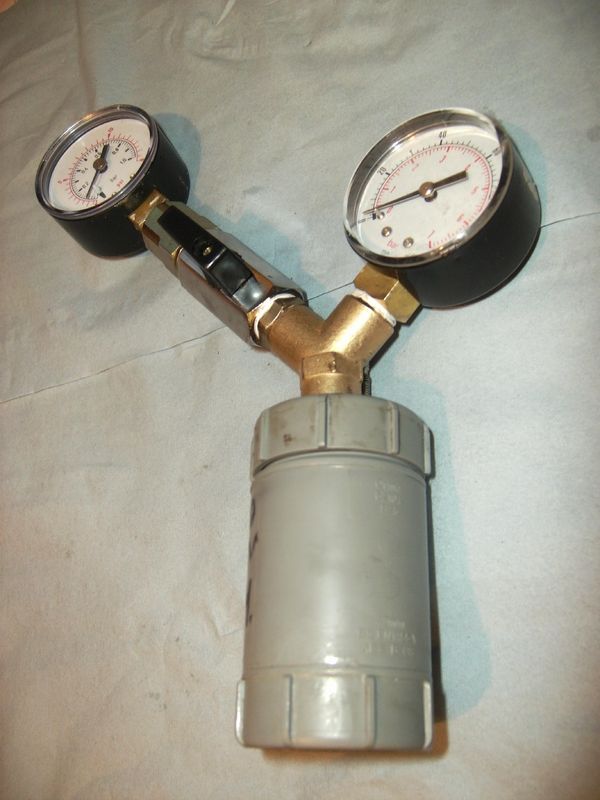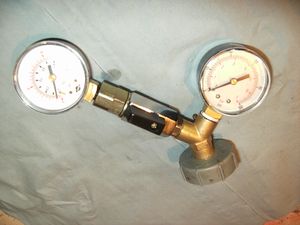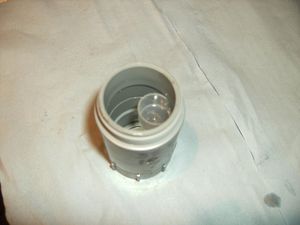Difference between revisions of "Water in fuel - test kit"
| Line 93: | Line 93: | ||
HYDROGEN a highly explosive gas is made using this kit | HYDROGEN a highly explosive gas is made using this kit | ||
| + | |||
| + | <gallery caption="Click pictures to enlarge" widths="300px" heights="300px" perrow="2" align="center"> | ||
| + | File:KN_water_test_kit_003.jpg|Gauge assembled | ||
| + | File:KN_water_test_kit_001.jpg|Inside view | ||
| + | </gallery> | ||
| + | |||
==See also== | ==See also== | ||
Revision as of 20:04, 4 August 2011
How to make a cheap water test kit,this wont have the accuracy of the well known version but is more portable than a manometer.
The accuracy is reliant on the quailty of the gauges bought.
Contents
The TOC tag creates a content box. The text it contains is generated automatically based on the page headings. Delete this text once you have read it.
Parts list
- 1/4" pressure gauge 0-15 psi
- 1/4" pressure gauge 0-100 psi
- 1/4" Y piece
- 1/4" Ball valve
- Bicycle "presta" valve
- 1/4" male stopend
- 2 x 43mm solvent weld access plugs
- 43mm solvent weld joiner
- Small plastic cap/cup
- Small marble
- Viton O ring
Instead of the presta valve and 0-15 gauge you can use a low pressure gauge designed for motorcycle forks which has a button for releasing the pressure
total cost roughly £20 (dependent on gauges used)
Assembly instuctions
- Put the plumbing together as in the photo with the low pressure gauge on the valved side
- Drill a hole in the stopend
- Weld both access plugs to the joiner
- Weld one screw cap on
- Drill two holes in the unwelded cap,one for the male stopend,one for the presta valve
- Fit the stopend through the hole into the Y piece and seal (i used araldite)
- Fit the valve using two of the round nuts that stop the valve creeping and seal
- Replace the rubber seal in the lid with a Viton one
- Glue the small cap to the inside about 3/4" down
- Drop in the marble
Second sub-heading here
- Click pictures to enlarge
Ingredients
The reagent Dry solvent
This kit will work with Calcium Hydride (CaH2) and Calcium Carbide (CaC2)as the reagent,the Hydride gives a quicker result and produces more gas (hydrogen) but is hard to source whereas Carbide is available from a well known auction site (£15/500g @4/2011 ) For a dry solvent you can use petrol or white spirits
The idea
The idea is that any water in the test liquid will react with the calcium and produce a gas (hydrogen),the pressure created is registered on the gauges The dry solvent dilutes the test liquid and allows any water present to get to the reagent quicker
The method
With my one shown above ive found that 35ml of test liquid and 10ml of dry solvent combined with 7gr of Calcium Carbide is an ideal amount. I grind 7 grammes of calcium and place in the small holder inside then put the two liquids into the vessel,screw the lid on and invert and shake (the marble helps the mixing action)there should be an immediate showing on the lower gauge,keep and eye on the gauge and if it looks like its going to go off the scale shut the valve to the lower gauge and read off the higher one Take the reading at a set amount of time and try to keep the temp of the tests as constant as posible The one shown will give a reading from 11 psi with dry oil upto 80 psi with a water content of 4000 ppm The cycle valve is for releasing a fast rising pressure or when finished This type of valve has a knurled nut which i leave undone so if the pressure starts to rise too high it can be released by touching a implement such as a screwdriver to it (DO NOT USE YOUR FINGER)
Calibrating
Obviously the more accurate you are with this the better the accuracy of the finished kit I used new vegetable oil and distilled water to make up various PPM mixes and plotted the result on a graph,this is then used when test your liquid,make sure the vessel is cleaned well between tests
Warning
Do not use on a liquid that is obviously wet,i have taken mine above 80psi and when it reaches its limit the gas escapes from the threaded cap BUT there is a danger it could explode at high pressures
HYDROGEN a highly explosive gas is made using this kit
- Click pictures to enlarge
See also
Use if there are similar pages in the wiki, if not delete.
- Link within this wiki here
- Link within this wiki here
- Link within this wiki here
References
Use if you need to cite reference material you've used , if not delete.
- First ref here
- Second ref here
Further reading
Use if you can detail any useful reading matter, if not delete.
- Book details here
- Book details here
- Book details here
External links
Use if you can list any useful links on the internet, if not delete.
- Link outside this wiki here
- Link outside this wiki here
- Link outside this wiki here
Originator to sign and date here by using 4 "squiggle marks"
... delete this "nowiki" tag once you have set your categories (it's just there to stop this section getting indexed on the main page!)
Add categories ... By using categories your page will get indexed on the wiki main page.
For Biodiesel ...
[[Category:Biodiesel]] sets the main category.
Now select one from the following, deleting the others:
[[Category:Introduction to Biodiesel]]
[[Category:Ingredients and preparation]]
[[Category:Processing methods]]
[[Category:Processors and equipment]]
[[Category:Finishing]]
[[Category:Safety and Testing]]
Do the same for Veg oil ...
[[Category:vegetable oil]]
Select one from the following, and delete the others:
[[Category:Introduction to veg oil use]]
[[Category:Collection & regulations]]
[[Category:Filtration & drying equipment]]
[[Category:Testing]]
[[Category:Vehicle modifications]]
If your page is applicable to both veg and bio, you can have a total of four category listings.
Please Note: To get your page indexed on the main page it is necessary, to got to the main page, click the edit tab and then click save.
... delete this "/nowiki" tag once you have set your categories (it's just there to stop this section get


